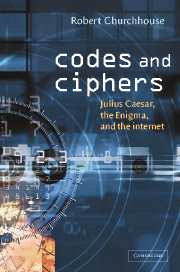Book contents
- Frontmatter
- Contents
- Preface
- 1 Introduction
- 2 From Julius Caesar to simple substitution
- 3 Polyalphabetic systems
- 4 Jigsaw ciphers
- 5 Two-letter ciphers
- 6 Codes
- 7 Ciphers for spies
- 8 Producing random numbers and letters
- 9 The Enigma cipher machine
- 10 The Hagelin cipher machine
- 11 Beyond the Enigma
- 12 Public key cryptography
- 13 Encipherment and the internet
- Appendix
- Solutions to problems
- References
- Name index
- Subject index
4 - Jigsaw ciphers
Published online by Cambridge University Press: 13 August 2009
- Frontmatter
- Contents
- Preface
- 1 Introduction
- 2 From Julius Caesar to simple substitution
- 3 Polyalphabetic systems
- 4 Jigsaw ciphers
- 5 Two-letter ciphers
- 6 Codes
- 7 Ciphers for spies
- 8 Producing random numbers and letters
- 9 The Enigma cipher machine
- 10 The Hagelin cipher machine
- 11 Beyond the Enigma
- 12 Public key cryptography
- 13 Encipherment and the internet
- Appendix
- Solutions to problems
- References
- Name index
- Subject index
Summary
In this chapter we look at a number of cipher systems which are based upon a different idea to those that we have met so far. In these systems each letter retains its own identity and so the frequencies of the individual letters of the messages are unchanged but the constituent letters of the digraphs, and the higher order polygraphs, are separated and, consequently, their original plaintext frequencies are destroyed. Since the method used in trying to solve them is rather like that of piecing together a jigsaw I have grouped them under the (unofficial) name of ‘jigsaw ciphers’. The simplest such systems are called
Transpositions
The cipher systems that we have examined in the earlier chapters have been based on substitution alphabets, where each letter is replaced by another letter but the order of the letters in a message is unchanged. An alternative approach is to leave the letters of the message unaltered but change their order. The result is that the cipher message is an anagram of the plaintext message. The simplest way of doing this to use a transposition system.
Simple transposition
In a simple transposition system the message is first written into a box, usually a rectangle, which has been divided up into squares by a number of horizontal and vertical lines. The number of vertical lines is fixed by a numerical or literal key; the number of horizontal lines may be fixed or may be determined by the length of the message.
- Type
- Chapter
- Information
- Codes and CiphersJulius Caesar, the Enigma, and the Internet, pp. 40 - 53Publisher: Cambridge University PressPrint publication year: 2001



